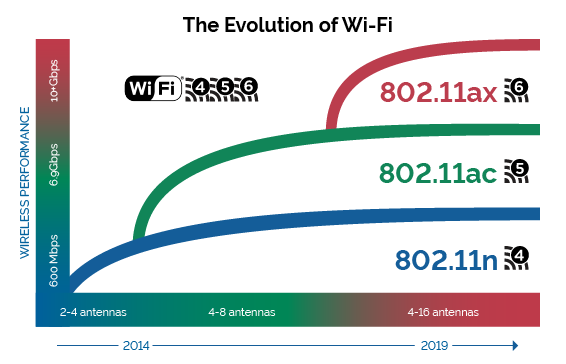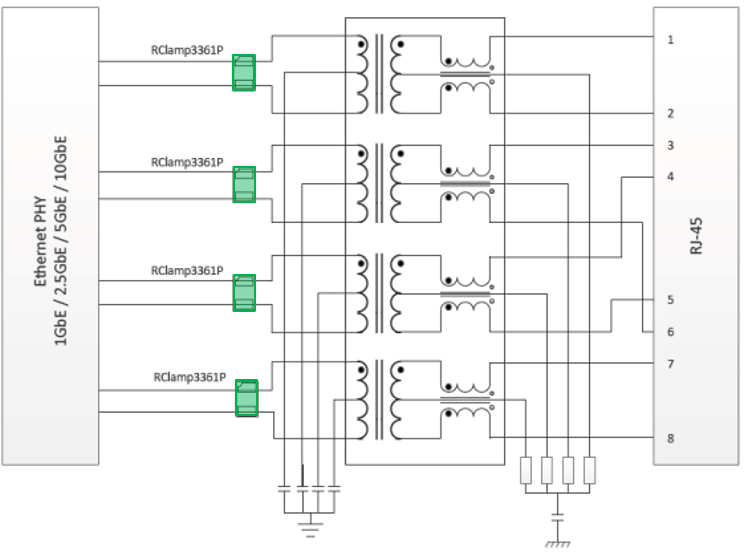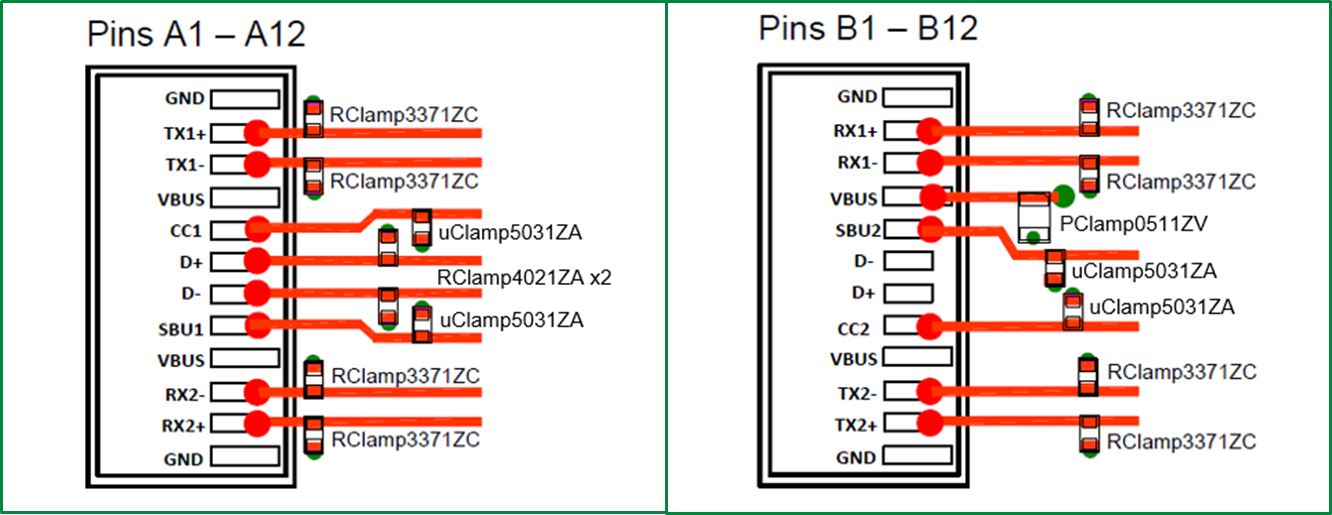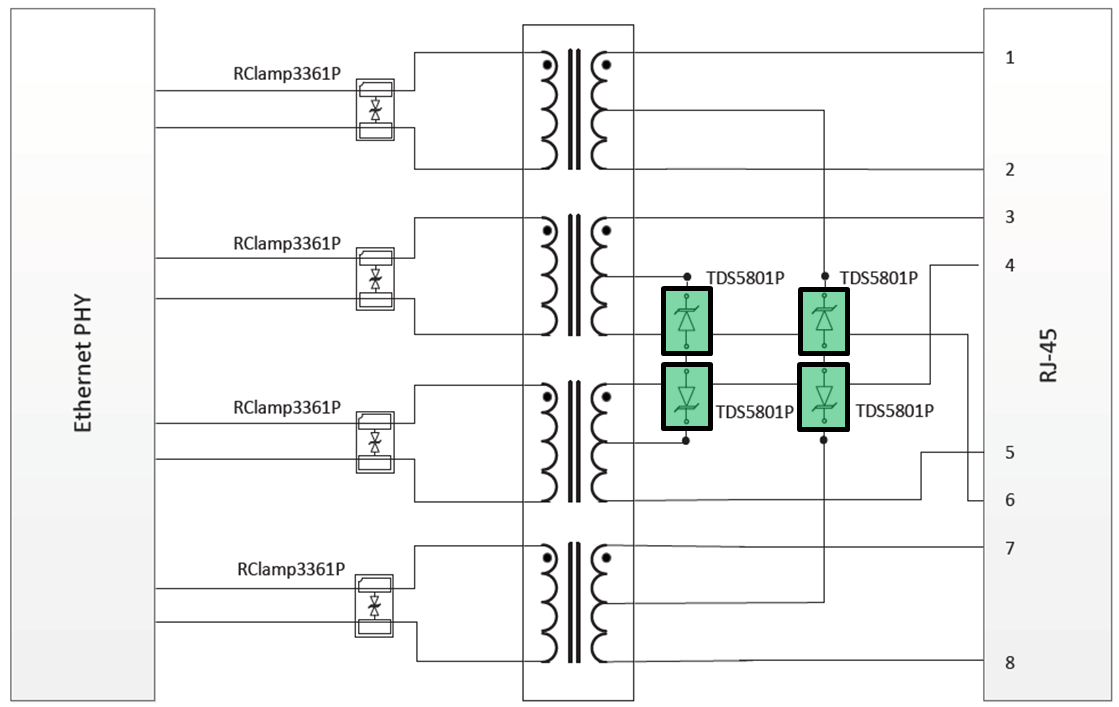Wi-Fi 6/6Eルーターを過電圧の脅威から守るために
Wi-Fi技術は、高度に接続された社会に遍在するようになりました。1997年の標準化以来、Wi-Fiプロトコルは進化を続け、より高速なデータレートと高いスループットを実現しています。
The most current generation of Wi-Fi (Wi-Fi 6/6E) operates at 2.4/5/6GHz (6E) and features tri-band connectivity capable of achieving theoretical data rates of 600Mbps, 6.9Gbps and 9.6Gbps, respectively (see Figure 1). While Wi-Fi 6 and 6E technologies bring gigabit speeds per spatial stream, the Wi-Fi 6E designation supports the 6GHz wireless spectrum, offering wider channels, a contiguous spectrum, less interference, and extremely low latency.
 Figure 1. The evolution of Wi-Fi - Source: Airgain
Figure 1. The evolution of Wi-Fi - Source: Airgain
Wi-Fi Routers
The centerpiece of the Wi-Fi revolution is the wireless router. The Wi-Fi router functions as the internet gateway. It connects Wi-Fi-enabled devices such as computers, printers, tablets, smartphones, smart TVs, and the Internet of Things (IoT) to the internet.
These routers feature many data connectivity ports to enhance the user experience. Wi-Fi 6/6E routers typically feature multiple high-speed wired network interfaces, including Ethernet, USB and Wi-Fi antenna ports. It is also common to find routers with xDSL, Cable DOCSIS, or an optical modem integrated. Moreover, some routers offer Power over Ethernet (PoE) as an option for power source, and many use DC power.
As users often interact and handle these data ports, they can be highly vulnerable to transient overvoltage threats like electrostatic discharge (ESD), cable discharge (CDE) or surge events. System designers must protect these routers from the harsh system ESD, electrical fast transient (EFT) and electrical overstress (EOS) threats with external system-level ESD and surge protection devices to ensure product robustness. Transient Voltage Suppressors (TVS) offer key electrical characteristics for protecting router interfaces from these overvoltage threats.
Wi-Fi Antenna Protection
When protecting the sensitive Wi-Fi transceiver against ESD strikes on the antenna and maintaining optimal RF performance, it is essential to review the TVS datasheet and select the proper device with suitable electrical characteristics. Key considerations should be TVS working voltage (Vrwm), linearity and capacitance.
Since Wi-Fi 6 antenna operates on the 2.4/5GHz wireless spectrum and Wi-Fi 6E adds support for the new 6GHz band, low capacitance TVS is required to minimize insertion loss and return loss. TVS capacitance characteristics should also be as constant over the reverse voltage range to reduce harmonic distortion. The majority of Wi-Fi 6/6E routers are operating in low power (indoor) mode, which has a maximum power spectrum density (PSD) of 27dBm @160MHz channel. Hence, TVS's working voltage needs to be above the peak amplitude of the transmit power to guarantee TVS operates in a high impedance state during normal operation.
Figure 2 below shows the low capacitance, high linearity Semtech TVS, RClamp1851ZA, protecting the Wi-Fi 6/6E antenna port.
 Figure 2: Protection of the Wi-Fi 6/6E antenna port with RClamp1851ZA
Figure 2: Protection of the Wi-Fi 6/6E antenna port with RClamp1851ZA
High-speed Data Line Protection
Wi-Fi 6/6E routers usually feature multiple high-speed interfaces such as Ethernet and USB ports. The main challenge in protecting these high-speed ports is maintaining the signal integrity of the high-speed differential signals while ensuring the transceiver IC is well protected from transient events.
To maintain the signal integrity of the high-speed lines, it is critical to minimize the capacitive load introduced by the TVS. Additionally, fast TVS turn-on time and low ESD/surge clamping voltage will protect downstream transceivers from harmful transient energy. Figure 3 below shows the low capacitance, low clamping, high surge Semtech TVS, RClamp3361P, protecting the multi-gig Ethernet port.

Figure 3: Protection of the multi-gig Ethernet port with RClamp3361P
Similarly, the USB Type-C port is susceptible to ESD and surge events. Figure 4 shows the recommended Semtech TVS devices protecting the Type-C pins.

Figure 4: Protection of the USB Type-C connector
Some Wi-Fi 6/6E routers have xDSL G.Fast modem integrated to enable fiber-like speeds for FTTx applications. Figure 5 shows an example of the Semtech TVS, TClamp2492S, protecting the G.Fast line driver.

Figure 5: Protection of the G.Fast line driver with TClamp2492S
Power Line Protection
During a surge event, power stability is critical to prevent catastrophic failure of the W-Fi 6/6E routers. One of the ways to guarantee router robustness is by adding external protection to the power line. The below table shows the Semtech uClampxx61P series of devices that offer VBUS and Power line protection for Wi-Fi 6/6E routers and general-purpose I/Os.
| Part Number | # of Lines | Config | VRWM | ESD Rating Contact/Air | Surge Rating (8/20us) | Clamping Voltage (8/20us) | Cap (Max) | Operating Temp (°C) | Package Dimensions (mm) |
| uClamp0561P | 1 | Unidirectional | 5V | 30kV / 30kV | 80A | 15V | 800pF | -40 to +125 | 1.6 x 0.80 x 0.5 |
| uClamp1061P | 1 | Unidirectional | 10V | 30kV / 30kV | 60A | 25V | 350pF | -40 to +125 | 1.6 x 0.80 x 0.5 |
| uClamp1261P | 1 | Unidirectional | 12V | 30kV / 30kV | 45A | 33V | 275pF | -40 to +125 | 1.6 x 0.80 x 0.5 |
| uClamp1561P | 1 | Unidirectional | 15V | 30kV / 30kV | 40A | 40V | 220pF | -40 to +125 | 1.6 x 0.80 x 0.5 |
| uClamp2461P | 1 | Unidirectional | 24V | 30kV / 30kV | 23A | 65V | 165pF | -40 to +125 | 1.6 x 0.80 x 0.5 |
| uClamp3061P | 1 | Unidirectional | 30V | 30kV / 30kV | 18A | 65V | 155pF | -40 to +125 | 1.6 x 0.80 x 0.5 |
| uClamp3661P | 1 | Unidirectional | 36V | 30kV / 30kV | 18A | 70V | 150pF | -40 to +125 | 1.6 x 0.80 x 0.5 |
| uClamp4061P | 1 | Unidirectional | 40V | 30kV / 30kV | 12A | 80V | 125pF | -40 to +125 | 1.6 x 0.80 x 0.5 |
| uClamp6061P | 1 | Unidirectional | 60V | 30kV / 30kV | 8A | 105V | 110pF | -40 to +125 | 1.6 x 0.80 x 0.5 |

Figure 6: Protection of the VBUS with uClampxx61P
Another power implementation is Power over Ethernet (PoE). Some routers support PoE as an alternate power source. Typically, PoE is integrated on the Wide Area Network (WAN) port of the router with a nominal supply voltage of 48V. Figure 7 shows ' 'Semtech's SurgeSwitch™ TDS5801P protecting the center tap of the RJ45 connector.

Figure 7: Protection of PoE with TDS5801P
Conclusion
Today's latest Wi-Fi routers are increasingly vulnerable to damage from transient voltage spikes. However, with some forethought at the early stages of the circuit design, these systems can be safeguarded using TVS protection devices at each critical data interface. Semtech is a recognized and trusted leader in circuit protection and offers many solutions to some of the most challenging ESD and surge protection challenges. Please read more about our solutions on our website.
Semtech®, the Semtech logo, RClamp®, SClamp®, and TClamp® are registered trademarks or service marks, and SurgeSwitch™ is a trademark or service mark of Semtech Corporation or its affiliates. Other product or service names mentioned herein may be the trademarks of their respective owners.
